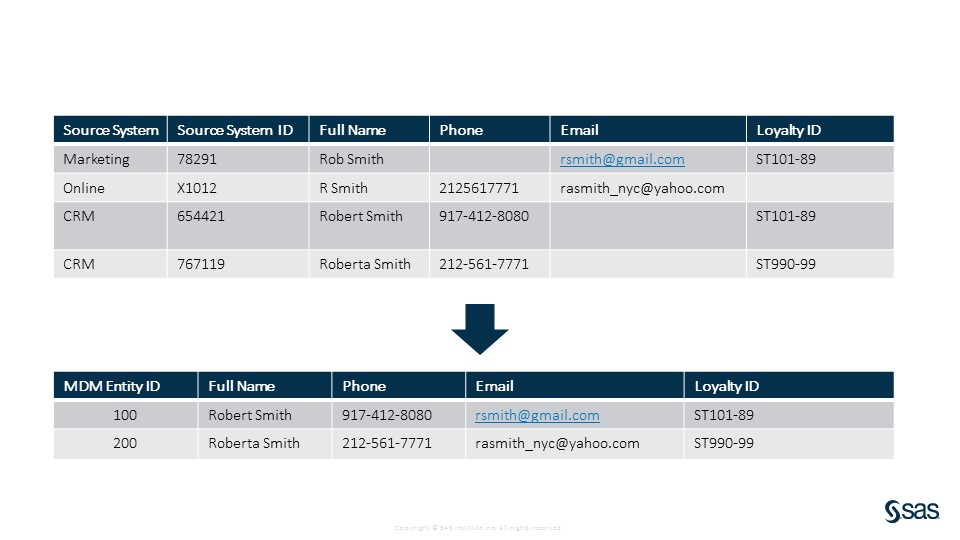Historically, organizations have used MDM applications to perform the following key functions:
- Collection: Gather the data.
- Consolidation: Find relations among different data elements.
- Storage: (Let's hope that this is self-explanatory.)
- Distribution: Provide consolidated views of employees, customers, etc.
- Control and consistency: This prevents pernicious duplicate records from appearing and contaminating receiving systems.
- Maintenance: Ensure that master data goes where it needs to go.
Visually, we can see how four records become two master records through matching and merging:
To be sure, plenty of large organizations can now easily produce master lists of customers, employees and the like. Beyond that, they have integrated MDM applications into key business processes including: sales, customer service, manufacturing, purchasing, billing and accounting. Master records seamlessly cascade into downstream systems. Brass tacks: Thorny data-quality issues rarely appear.
As organizations become more mature in their MDM efforts, I'd like to look at four trends that I expect to accelerate in the next few years.
MDM as a backbone for analytics
Now that many organizations are handling the basic blocking and tackling, it's time to move beyond mere "collection" and "maintenance" (see above) and into more strategic uses for their data. More will begin to see MDM as a type of incredibly valuable meta-database. All of this information doesn't just allow them to do analytics; it invites analytics.
Integration with Hadoop and unstructured data
I've been predicting this one for a while now. It turns out that I'm not alone. As Prash Chandramohan writes, organizations are beginning to apply MDM techniques to unstructured data. This may be as simple as linking master data to data from Facebook, Twitter, Linkedin and other social networks.
Beyond that, organizations are looking for ways in which they can offload some of their existing MDM processing to Hadoop. Given the latter's immense processing power and fault tolerance, this should ensure that they receive data quickly and reliably. Increased speed is a good thing.
Industry-specific MDM solutions
Now that MDM is starting to mature, people are finally realizing that one size doesn’t fit all. We are starting see solutions tailored to specific industries. For instance, healthcare organizations face different business needs and regulatory hurdles than their retail counterparts. Big-box retailers such as Home Depot don’t have to deal with patients and the Health Insurance Portability and Accountability Act (HIPAA).
Outward-facing MDM
Many if not most organizations currently use MDM exclusively to manage their internal systems. This is starting to change. Amazon, Walmart and Target often work with external partners and vendors who need accurate product information. MDM applications are evolving to allow simple import/export functionality, increasingly via the lightweight and data-rich JavaScript Object Notation (JSON) format.
Simon Says
Stay tuned. The next decade of MDM may not look very much like the previous one.
Feedback
What say you?
Download a Strategic Guide to Data Governance and MDM





